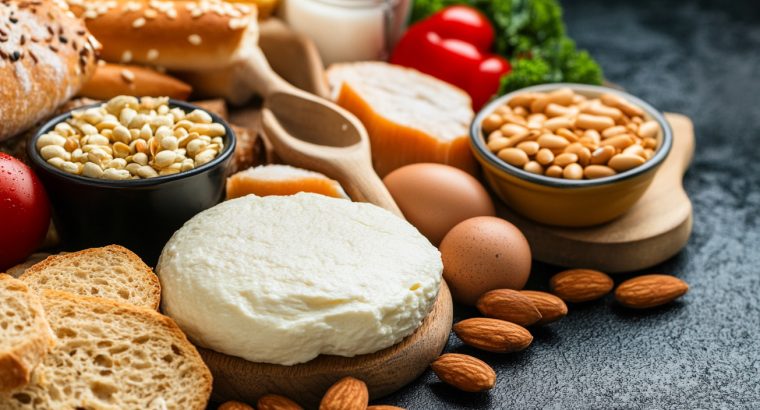Navigating Food Allergies and Diabetes
Food allergies and diabetes are two dietary challenges that individually require careful management. When combined, they present a complex set of considerations for anyone trying to navigate their dietary needs effectively. This guide aims to provide insights into managing both food allergies and diabetes, so you can maintain a balanced and enjoyable diet without compromising health.
Understanding Food Allergies
What Are Food Allergies?
Food allergies occur when the body’s immune system mistakenly identifies certain proteins in food as harmful. This reaction can trigger a range of symptoms, from mild hives or a runny nose to severe, life-threatening anaphylaxis.
Common Food Allergens
Eight foods account for the most serious and prevalent allergic reactions:
- Milk
- Eggs
- Peanuts
- Tree nuts
- Fish
- Shellfish
- Soy
- Wheat
Understanding which foods trigger your allergies is crucial for treatment and prevention.
Understanding Diabetes
What Is Diabetes?
Diabetes is a chronic condition that affects how your body processes blood sugar (glucose). The main types of diabetes include:
- Type 1 Diabetes: An autoimmune condition where the body does not produce insulin.
- Type 2 Diabetes: A metabolic disorder where the body becomes resistant to insulin or doesn’t produce enough.
- Gestational Diabetes: Occurs during pregnancy and usually resolves after childbirth, though it can increase the risk of Type 2 diabetes later in life.
Key Diet Considerations for Diabetes
Managing diabetes typically involves monitoring carbohydrate intake and maintaining balance in blood sugar levels through diet, exercise, and medication if necessary.
Challenges of Managing Both
When you need to consider both food allergies and diabetes, each meal becomes a balancing act. You must ensure foods are safe from allergens while also managing carbohydrate intake to maintain stable blood glucose levels.
Key Challenges Include:
- Limited dietary choices due to both allergies and carbohydrate restrictions.
- The need for constant meal planning and readiness.
- Reading and interpreting complex food labels.
- Finding suitable substitutes for allergenic ingredients that also meet dietary guidelines for diabetes.
Strategies for Managing Dual Dietary Needs
With careful planning and strategic choices, you can maintain a diet that manages both food allergies and diabetes without sacrificing taste or nutritional value.
1. Collaborate with Health Professionals
Consult with allergists, dietitians, and endocrinologists to develop a personalized eating plan that caters to both your allergies and diabetic needs.
2. Keep a Food Diary
Record everything you eat and note how your body reacts—this can help identify potential allergens and understand how different foods impact your blood sugar levels.
3. Learn to Interpret Food Labels
Become proficient at reading food labels to check for allergens and carbohydrate content. Familiarize yourself with alternative names for common allergens (e.g., casein or whey for milk, albumin for eggs).
4. Focus on Whole Foods
Whole foods are less likely to contain hidden allergens and often have more predictable effects on your blood glucose levels. Prioritize:
- Fruits and Vegetables: Naturally gluten- and allergen-free, low in carbohydrates (considering portion sizes).
- Whole Grains: Brown rice, quinoa, and oats (checked for contamination if you have a gluten allergy).
- Lean Proteins: Chicken, turkey, legumes (checking for cross-contamination).
- Healthy Fats: Avocado, olive oil, and nuts (if no nut allergy).
5. Modify Recipes
Adapt recipes to eliminate allergens without increasing carbohydrates. Use ingredients like:
- Dairy Alternatives: Opt for almond milk (allergy permitting), lactose-free milk, or coconut milk.
- Egg Substitutes: Use flaxseed meal or commercial egg replacers in baked goods.
- Nut-Free Butters: Sunflower seed or soy nut butter are great alternatives.
6. Be Creative with Flavors
Herbs and spices can elevate the taste of any dish without adding calories, sugar, or allergens. Experiment with:
- Basil
- Oregano
- Cumin
- Cinnamon
- Ginger
7. Plan for Eating Out and Travel
Research restaurants for allergen-friendly and diabetes-sensitive menus. Always inform your server about your dietary restrictions and preferences.
Importance of Consistent Monitoring
Monitor Blood Glucose Levels
Regularly check your blood sugar levels to understand how different foods affect your diabetes management.
Stay Aware of Food Labels and Ingredients
The food industry constantly evolves, with changes in recipes or manufacturing processes. Regularly verify the ingredients and nutritional information of packaged foods.
Emergency Preparedness
Always carry medication, such as insulin or epinephrine auto-injectors, to manage unexpected reactions or blood sugar fluctuations.
Psychological and Emotional Support
Coping with both food allergies and diabetes can be stressful. It’s important to seek support from friends, family, and healthcare providers. Consider joining support groups for shared experiences and practical tips.
Conclusion
Managing food allergies and diabetes simultaneously may seem daunting, but with careful planning and mindful choices, it’s certainly achievable. While it involves ongoing vigilance, the results—a balanced, nutritious, and safe diet—are well worth the effort. By leveraging expert advice, documenting your dietary habits, and using creativity in meal preparation, you can enjoy a healthy lifestyle that accommodates both your allergy sensitivities and diabetic needs.
In the journey of managing these two complex dietary conditions, remember that small, consistent steps towards better understanding your own body’s responses can lead to sustainable health and well-being.

